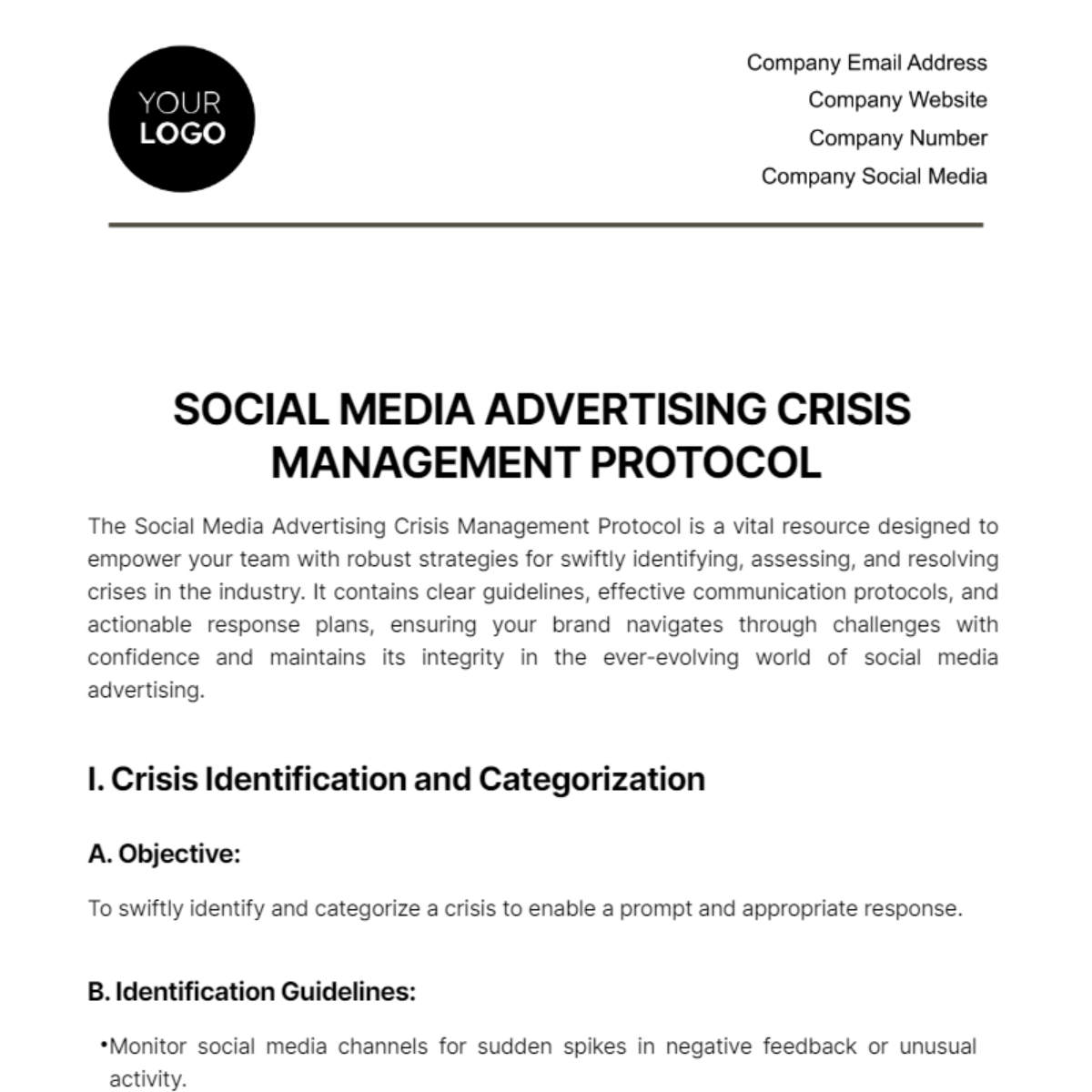Free Social Media Advertising Crisis Management Protocol

The Social Media Advertising Crisis Management Protocol is a vital resource designed to empower your team with robust strategies for swiftly identifying, assessing, and resolving crises in the industry. It contains clear guidelines, effective communication protocols, and actionable response plans, ensuring your brand navigates through challenges with confidence and maintains its integrity in the ever-evolving world of social media advertising.
I. Crisis Identification and Categorization
A. Objective:
To swiftly identify and categorize a crisis to enable a prompt and appropriate response.
B. Identification Guidelines:
Monitor social media channels for sudden spikes in negative feedback or unusual activity.
Regularly scan for technical issues affecting ad performance or viewer experience.
C. Crisis Categories:
Technical Failures: Issues like website downtime, broken links in ads, etc.
Negative Feedback: Large volumes of adverse reactions or complaints.
PR Incidents: Situations that could harm the company's public image.
II. Communication Protocol
A. Objective:
Establish clear communication channels and response protocols.
B. Crisis Team:
Assemble a team including members from marketing, PR, and customer service. Assign a designated spokesperson for public communications.
C. Communication Procedures:
Internal communication via designated channels.
External communication should be timely, transparent, and consistent across all platforms.
III. Crisis Assessment and Analysis
A. Objective:
Accurately assess the crisis and its potential impact.
B. Information Gathering:
Use social media monitoring tools to track mentions and sentiment. Collect data on the scope and scale of the crisis.
C. Risk Assessment:
Evaluate potential impacts on brand reputation and ad campaign effectiveness.
IV. Action Plan and Response Strategies
A. Objective:
Implement a structured response to mitigate the crisis.
B. Action Steps:
For technical issues, coordinate with IT for quick resolution.
For negative feedback, address concerns publicly and offer resolutions.
For PR incidents, work with the PR team for a suitable public statement.
C. Response Strategies:
Tailor responses to the nature and severity of the crisis.
Ensure all responses align with the brand's values and messaging guidelines.
V. Post-Crisis Evaluation and Report
A. Objective:
Reflect on the crisis management process and improve future protocols.
B. Evaluation Process:
Analyze the effectiveness of the response strategies.
Gather feedback from the crisis team and stakeholders.
C. Reporting:
Document the crisis timeline, actions taken, and outcomes.
Create a report with recommendations for future improvements.
- 100% Customizable, free editor
- Access 1 Million+ Templates, photo’s & graphics
- Download or share as a template
- Click and replace photos, graphics, text, backgrounds
- Resize, crop, AI write & more
- Access advanced editor
Navigate digital crises confidently and effectively with Template.net's Social Media Advertising Crisis Management Protocol Template. Meticulously tailored for immediate, effective response strategies, this template is vital for maintaining brand integrity, customer trust, and reputation during challenging, unpredictable high-stakes situations. This template offers the peace of mind needed in today's fast-paced online environment.
You may also like
- Instagram Ad
- Instagram Banner
- Instagram Frame
- Instagram Post
- Instagram Profile Picture
- Instagram Story
- Instagram Story Highlights
- Twitter Ad
- Twitter Header
- Twitter Post
- LinkedIn Photo
- Linkedin Post
- YouTube
- Youtube Ad
- Youtube Banner
- YouTube Channel Art
- YouTube End Screen
- Youtube Profile Photo
- YouTube Thumbnail
- Facebook Ad
- Facebook Cover
- Facebook Post
- Facebook Profile Frame
- Facebook Profile Photo
- Twitch Offline Banner
- Linkedin Banner
- Twitch Overlay
- Whatsapp Status
- Reddit Banner
- Social Media Banner
- Social Media Clipart
- Social Media Plan
- Social Media Contract
- Social Media Planner
- Social Media Report
- Social Media Agreement
- Social Media Business Card
- Social Media Proposal
- Social Media Presentation





























